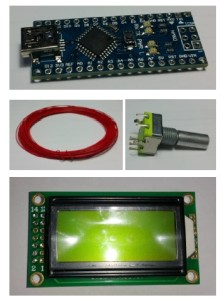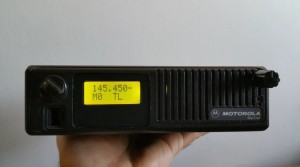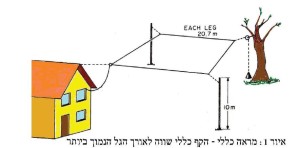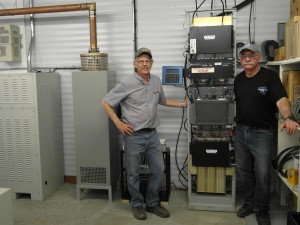- Home
- Registration
- Site Tools
- Articles
- Swap n Shop
- Contesting
- Grounding information for everyone
- History of the Central Alberta Amateur Radio Club
- CAARC owned Repeaters
- Club Repeater Info
- GMT Time Conversion Table
- VE/VA6 Incoming QSL Bureau
- Pine Lake Tornado Friday July 14, 2000.
- Amateur Radio to the Rescue
- CANWARN
- HAM Nation with Bob Heil K9EID
- Net info
- Events.
- ARES
- Links and On line study course.
- Field Day 2019
- Members D/L
- Forum/Swap and Shop
Articles

Maxdroid
Sep 9th
Maxdroid
Modification to add a digital display and continuous frequency selection to VHF/UHF Maxtrac transceivers.
By
Avinoam Albo, 4X1HF Avinoam.albo@gmail.com
December 2014
Conversion of a Maxtrac to a transceiver with display and frequency selection
In this article I will explain how to convert the venerable Maxtrac to a rig more user friendly to radio amateurs. The modification requires  the addition of only a few inexpensive and easily available components. When the modification is completed you will have a rig with digital display and frequency selection enabling continuous  coverage over the whole range of frequencies  where the VCO locks. An external programmer is no longer needed.
Disclaimer: Carrying out the modification described requires basic electronics skills. Any modifications are the sole responsibility of the technician. This modification will likely void type certification for commercial radio service.  This article does not make any specific claims or recommendations.
Specifications of the transceiver after this modification
- Digital display
- Continuous frequency selection
- Selection of transmitter output power (2 levels or more)

- Selection using VFO or memories
- Selection of VFO frequency steps (5K, 10K, etc.)
- Receive PL (on/off)
- Scanning and saving frequencies to memory (future)
Required ComponentsÂ
- Maxtrac VHF or UHF
- Arduino Nano 328 controller
- Rotary encoder
- LCD 08 X 02 (8 characters x 2 lines)
- 3K, 4.7K, 8.2K, 10K resistors
- Fine gauge insulated hookup wire such as wire wrap wire
Programming the transceiver More >

Horizontal Quad Antenna
Sep 8th
Horizontal Quad Antenna
By: Eli Kovo, 4X4LH (originally published in the IARC newsletter 08/2015 “HaGal†and used with permission of the author.  Translated by: Earl, VA6TJ)
I recently came across an article in an issue of “73 Magazine†from 1978 raving about an antenna called “The German Quad†which [at that time] was used by about half the hams in Germany.  Below I summarize the main points of the article.
The first thing about this antenna is that it works without a tuner on 6 bands, from 10m to 80m and also on 2m. I could not find confirmation that it works on 6m however I am confident that it will also transmit on that band. Compared to a symmetrical dipole, the horizontal quad has the advantage that it can be fed anywhere, even at a point close to the shack as in illustration 1.
Guest Operation in Brazil during FIFA 2014 World Cup
Jun 9th
Guest Operation in Brazil during FIFA 2014 World Cup
 2014/06/09
The Brazilian Amateur Radio League – LABRE – has filed a request and obtained special permission from ANATEL, the Brazilian Telecommunication authority for foreign amateurs wishing to operate during the FIFA World Cup.
Radio amateur operators who visit Brazil for the 2014 FIFA World Cup will be able to be on air without bureaucracy. During June and July, any foreign amateur will be able to operate in Brazil regardless of the existence of reciprocity agreement between countries. No IARP or CEPT license are necessary and no fees are required.
Amateurs who wish to operate in Brazil must send to LABRE the following documents
– Copy of a valid passport (identification pages)
– Copy of amateur radio license of his/her country
– List of cities in which he/she intends to operate and the respective periods
– Email address for contact
The documents must be scanned and sent to executiva@labre.org.br
For further information, contact George Gorsline, VE3YV RAC International Affairs Officer.
VE3YV@rac.ca
Why We Are Ham Radio Operators
Apr 8th
Why Amateur Radio is Important
Roger Hunt, K7MEX
A version of this story appeared in the March 2014 edition of All Ears, the newsletter
published by the Escondido Amateur Radio Society (EARS) in California. I spoke with the
primary person involved in this incident, got some corrections to the original version of the
story, and the corrected version appears below.
There is a large off-road 4WD event in the Lake Havasu area held the third weekend of
March each year. Called Desert Run Havasu, it was March 13-16 this year, and involves
4-wheeling runs over trails of varying difficulty. One indvidual who participated this year
was retired attorney Bruce Boogaard, a new ham with the call sign KK6DKJ. Bruce got his
technician license less than a year ago, in April 2103, and admits he has never even been
on a repeater before, using his radios for simplex communication with other 4-wheelers.
Participating in the Desert Run Havasu, Bruce was navigating through an area with a large
group of off-road enthusiasts, and as he had been taught to do, kept his eyes on the
vehicle both in front and behind him. While most of the group used CB radios, Bruce and
another ham named Scott Connelly also kept in touch on a VHF ham frequency. Scott was
near the front of the group, while Bruce was near the rear. The group became widely
separated, with nearly two miles between the first and last vehicles in the group. The
distance proved to be a problem in the difficult terrain and some of the vehicles using CB
radios lost communication. However Bruce and Scott were able to maintain contact with
their ham radios.
Bruce eventually noticed the second vehicle behind him was driving erratically and falling
further behind. When the vehicle made a strange turn up the side of the wash, Bruce
contacted Scott and asked that he relay a message to the group leader by CB radio to stop.
Bruce turned back and checked on the driver, discovering he was incoherent and obviously
having some kind of medical emergency. Bruce updated Scott as to the problem and
stated they needed to get this guy to hospital as soon as possible. There was no cell
service in this remote area, but Bruce had brought with him the frequency and PL tone of
a nearby repeater. Though Bruce had never used a repeater, he was preparing to put the
information into the radio when he received a call on the simplex frequency, 146.550 MHz,
that he had been using to talk to Scott.
As luck would have it, a group of hams belonging to the Family Motor Coach Association
(FMCA) were having an RV ralley in the Lake Havasu area and were using the same
simplex frequency. He heard Bruce’s call to Scott, and since he had cell service where he
was located, offered to call 9-1-1. An ambulance was dispatched to the nearest trail head,
and the 4-wheelers were able to get the man there in about 20-25 minutes. The man was
transferred to the ambulance and later transported via Life Flight to a hospital in Phoenix.
It turned out the man had a blood vessel burst in his brain, but survived, partly because of
the quick action of the amateur radio operators involved. This incident is a classic example
of why ham radio helps save lives, and works when all else fails.
RAC – RFinder agreement
Mar 5th
WWW.RAC.CA WWW.RFINDER.NET
March 3rd 2014
RADIO AMATEURS OF CANADA PARTNER UP WITH RFINDER
“THE WORDLWIDE REPEATER DIRECTORYâ€
Radio Amateurs of Canada (RAC) and RFinder are excited to announce a new business partnership
agreement effective March 1st. RAC endorses RFinder as the official Worldwide Repeater Directory for
all Canadian amateur radio operators.
The RFinder is a steadily growing worldwide repeater directory including IRLP, Echolink, AllStar, DStar,
MotoTRBO, and even Winlink information. RFinder currently have over 175 countries in the directory.
Access to the World Wide Repeater Directory is provided by any version of the RFinder smartphone
apps on Android, iPhone and iPad/iPod Touch. The same user-id enables access from any version
of the RFinder app, the browser interface (web.rfinder.net), or through a growing list of third-party
memory programming applications such as RT Systems radio programmers and CHIRP open source
software. One subscription, access to worldwide repeater data from any computing device on
Windows, Linux, OS X, web, Android iPhone and soon on Windows Phone!
Canadian hams purchasing the RFinder application will financially benefit the Radio Amateurs of Canada
through the terms of this new agreement.
“Obviously, going forward, we encourage all Canadian Amateurs to consider RFinder as their repeater
directory provider. RAC staff and volunteers will proactively work with RFinder on providing repeater
directory information updates for Canada as repeater directory information is a constantly changing
environment†notes Glenn MacDonell, VE3XRA, RAC Vice-President.
“Our partnership with RAC and the Amateur Radio community in Canada is a milestone in the
development of RFinder – The World Wide Repeater Directory. We offer the same agreement with
Radio Amateur societies world wide. This is a unique opportunity for each geography on Earth to have
their own branded Repeater Directory while giving their local Hams access to repeaters all over the
world, and financially supporting the local Amateur Radio advocacy group. We will translate to any
language!†says Bob Greenberg, W2CYK, creator of RFinder.
Canadian RFinder users will see a new graphic feature; the RAC logo appearing on their app as well.
RAC is the voice of amateur radio for all Canadians and is also a member society of the IARU
(International Amateur Radio Union).
Contact information:
RAC: Vincent Charron, VA3GX/VE2HHH, Dir. Comm. & Fundraising – hq.communications@rac.ca
RFinder: Bob Greenberg, W2CYK, creator – w2cyk@rfinder.net
Personally I prefer www.repeaterbook.com  Why wouldn’t I, it’s free!!!!!!!!!!
Bob Heil, (video casts) with various co-hosts and guests, will cover the excitement and importance of ham radio
Nov 24th
Bob Heil, with various co-hosts and guests, will cover the excitement and importance of ham radio – from tossing an antenna wire in a tree allowing you to talk to the world, to the importance of ham radio operators in time of disasters.
Records live every Wednesday at 6:00pm PT/9:00pm ET.  Also see drop down menu under ARTICLES.

NEW REPEATER VE6QE PACKAGE INSTALLATION TIME LAPSE VIDEO
May 23rd
This is a 13 second fast video of VE6BGT Skip and VE6BLD Bob installing the new VE6QE repeater package built by Skip over the past many months.
https://picasaweb.google.com/lh/photo/f0eRrxbZ1IvjoEpaS-62D9AAHgG5tvMXgEy_nVJXItk?feat=directlink
Click this link to watch a 4 minute video of the same video above
https://picasaweb.google.com/lh/photo/qnu9wrhjdKgoBuJDb4MdONAAHgG5tvMXgEy_nVJXItk?feat=directlink
New Brochure for the Central Alberta Amateur Radio Club
May 18th
I have produced a new Brochure for the Central Alberta Amateur Radio Club.
To download a color printable PDF document of the Club Advertising brochure complete with hot links back
to the web site  click this link
or check the second Tab under Site Tools menu.
Bob VE6BLD. Webmaster






